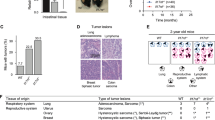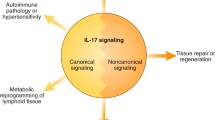Abstract
Interleukin 17 (IL-17) is an important cytokine that can induce tissue inflammation and is involved in the pathogenesis of numerous autoimmune diseases. However, the regulation of its signaling transduction has not been well described. In this study, we report that thousand and one kinase 1 (TAOK1) functions as a negative regulator of IL-17-mediated signal transduction and inflammation. TAOK1 knockdown promotes IL-17-induced cytokine and chemokine expression and the activation of mitogen-activated protein kinases and nuclear factor-κB. We further demonstrate that TAOK1 interacts with IL-17 receptor A (IL-17RA) independent of its kinase activity, and TAOK1 dose-dependently prevents the formation of the IL-17R-Act1 (nuclear factor activator 1, also known as tumor necrosis factor receptor-associated factor 3 interacting protein 2) complex. Consistent with this, TAOK1 deficiency exacerbates colitis in the 2,4,6-trinitrobenzenesulfonic acid)-induced experimental model of inflammatory bowel disease, likely by its promotion of the IL-17-mediated signaling pathway. TAOK1 expression is decreased in the colons of ulcerative colitis patients. In conclusion, these findings suggest that TAOK1 is involved in the development of IL-17-related autoimmune disorders.
This is a preview of subscription content, access via your institution
Access options
Subscribe to this journal
Receive 12 digital issues and online access to articles
$119.00 per year
only $9.92 per issue
Buy this article
- Purchase on Springer Link
- Instant access to full article PDF
Prices may be subject to local taxes which are calculated during checkout






Similar content being viewed by others
References
Iwakura Y, Ishigame H, Saijo S, Nakae S. Functional specialization of interleukin-17 family members. Immunity 2011; 34: 149–162.
Cua DJ, Tato CM. Innate IL-17-producing cells: the sentinels of the immune system. Nat Rev Immunology 2010; 10: 479–489.
Sutton CE, Lalor SJ, Sweeney CM, Brereton CF, Lavelle EC, Mills KH. Interleukin-1 and IL-23 induce innate IL-17 production from gammadelta T cells, amplifying Th17 responses and autoimmunity. Immunity 2009; 31: 331–341.
Cella M, Fuchs A, Vermi W, Facchetti F, Otero K, Lennerz JK et al. A human natural killer cell subset provides an innate source of IL-22 for mucosal immunity. Nature 2009; 457: 722–725.
Passos ST, Silver JS, O'Hara AC, Sehy D, Stumhofer JS, Hunter CA. IL-6 promotes NK cell production of IL-17 during toxoplasmosis. J Immunol 2010; 184: 1776–1783.
Beringer A, Noack M, Miossec P. IL-17 in chronic inflammation: from discovery to targeting. Trends Mol Med 2016; 22: 230–241.
Xiao F, Lin X, Tian J, Wang X, Chen Q, Rui K et al. Proteasome inhibition suppresses Th17 cell generation and ameliorates autoimmune development in experimental Sjogren's syndrome. Cell Mol Immunol 2017; 14: 924–934.
Zrioual S, Toh ML, Tournadre A, Zhou Y, Cazalis MA, Pachot A et al. IL-17RA and IL-17RC receptors are essential for IL-17A-induced ELR+ CXC chemokine expression in synoviocytes and are overexpressed in rheumatoid blood. J Immunol 2008; 180: 655–663.
Zhu S, Qian Y. IL-17/IL-17 receptor system in autoimmune disease: mechanisms and therapeutic potential. Clin Sci (Lond) 2012; 122: 487–511.
Zhu S, Pan W, Shi P, Gao H, Zhao F, Song X et al. Modulation of experimental autoimmune encephalomyelitis through TRAF3-mediated suppression of interleukin 17 receptor signaling. J Exp Med 2010; 207: 2647–2662.
Ma C, Lin W, Liu Z, Tang W, Gautam R, Li H et al. NDR1 protein kinase promotes IL-17- and TNF-alpha-mediated inflammation by competitively binding TRAF3. EMBO Rep 2017; 18: 586–602.
Song X, Qian Y. The activation and regulation of IL-17 receptor mediated signaling. Cytokine 2013; 62: 175–182.
Hutchison M, Berman KS, Cobb MH. Isolation of TAO1, a protein kinase that activates MEKs in stress-activated protein kinase cascades. J Biol Chem 1998; 273: 28625–28632.
Schlesinger TK, Fanger GR, Yujiri T, Johnson GL. The TAO of MEKK. Front Biosci 1998; 3: D1181–D1186.
Thies E, Mandelkow EM. Missorting of tau in neurons causes degeneration of synapses that can be rescued by the kinase MARK2/Par-1. J Neurosci 2007; 27: 2896–2907.
Draviam VM, Stegmeier F, Nalepa G, Sowa ME, Chen J, Liang A et al. A functional genomic screen identifies a role for TAO1 kinase in spindle-checkpoint signalling. Nat Cell Biol 2007; 9: 556–564.
Plouffe SW, Meng Z, Lin KC, Lin B, Hong AW, Chun JV et al. Characterization of Hippo Pathway components by gene inactivation. Mol Cell 2016; 64: 993–1008.
Zihni C, Mitsopoulos C, Tavares IA, Ridley AJ, Morris JD. Prostate-derived sterile 20-like kinase 2 (PSK2) regulates apoptotic morphology via C-Jun N-terminal kinase and Rho kinase-1. J Biol Chem 2006; 281: 7317–7323.
Raman M, Earnest S, Zhang K, Zhao Y, Cobb MH. TAO kinases mediate activation of p38 in response to DNA damage. EMBO J 2007; 26: 2005–2014.
Han NR, Lee H, Baek S, Yun JI, Park KH, Lee ST. Delivery of episomal vectors into primary cells by means of commercial transfection reagents. Biochem Biophys Res Commun 2015; 461: 348–353.
Zhao M, Yang H, Jiang X, Zhou W, Zhu B, Zeng Y et al. Lipofectamine RNAiMAX: an efficient siRNA transfection reagent in human embryonic stem cells. Mol Biotechnol 2008; 40: 19–26.
Han C, Gu H, Wang J, Lu W, Mei Y, Wu M. Regulation of l-threonine dehydrogenase in somatic cell reprogramming. Stem Cells 2013; 31: 953–965.
Wang C, Huang Y, Sheng J, Huang H, Zhou J. Estrogen receptor alpha inhibits RLR-mediated immune response via ubiquitinating TRAF3. Cell Signal 2015; 27: 1977–1983.
Zhang Z, Zheng M, Bindas J, Schwarzenberger P, Kolls JK. Critical role of IL-17 receptor signaling in acute TNBS-induced colitis. Inflamm Bowel Dis 2006; 12: 382–388.
Lin W, Ma C, Su F, Jiang Y, Lai R, Zhang T et al. Raf kinase inhibitor protein mediates intestinal epithelial cell apoptosis and promotes IBDs in humans and mice. Gut 2017; 66: 597–610.
Ratsimandresy RA, Indramohan M, Dorfleutner A, Stehlik C. The AIM2 inflammasome is a central regulator of intestinal homeostasis through the IL-18/IL-22/STAT3 pathway. Cell Mol Immunol 2017; 14: 127–142.
Gaffen SL. Structure and signalling in the IL-17 receptor family. Nat Rev Immunol 2009; 9: 556–567.
Gu C, Wu L, Li X. IL-17 family: cytokines, receptors and signaling. Cytokine 2013; 64: 477–485.
Fonseca-Camarillo G, Mendivil EJ, Furuzawa-Carballeda J, Yamamoto-Furusho JK. Interleukin 17 gene and protein expression are increased in patients with ulcerative colitis. Inflamm Bowel Dis 2011; 17: E135–E136.
Song X, He X, Li X, Qian Y. The roles and functional mechanisms of interleukin-17 family cytokines in mucosal immunity. Cell Mol Immunol 2016; 13: 418–431.
Boggiano JC, Vanderzalm PJ, Fehon RG. Tao-1 phosphorylates Hippo/MST kinases to regulate the Hippo-Salvador-Warts tumor suppressor pathway. Dev Cell 2011; 21: 888–895.
Ultanir SK, Yadav S, Hertz NT, Oses-Prieto JA, Claxton S, Burlingame AL et al. MST3 kinase phosphorylates TAO1/2 to enable myosin Va function in promoting spine synapse development. Neuron 2014; 84: 968–982.
Qian Y, Liu C, Hartupee J, Altuntas CZ, Gulen MF, Jane-Wit D et al. The adaptor Act1 is required for interleukin 17-dependent signaling associated with autoimmune and inflammatory disease. Nat Immunol 2007; 8: 247–256.
Liu C, Qian W, Qian Y, Giltiay NV, Lu Y, Swaidani S et al. Act1, a U-box E3 ubiquitin ligase for IL-17 signaling. Sci Signal 2009; 2: ra63.
Sun D, Novotny M, Bulek K, Liu C, Li X, Hamilton T. Treatment with IL-17 prolongs the half-life of chemokine CXCL1 mRNA via the adaptor TRAF5 and the splicing-regulatory factor SF2 (ASF). Nat Immunol 2011; 12: 853–860.
Acknowledgements
This work was supported by grants from the National Key Research and Development Program of China (2016YFA0502201), the National Natural Science Foundation of China (81571550, 81671613), the Natural Science Foundation of Zhejiang Province (LY18H100001, LY15H100001), the ‘Double First-rate’ project initiatives, the Shanghai Key Laboratory of Cell Engineering (14DZ2272300) and the Shanghai Leading Academic Discipline Project (B905).
Author information
Authors and Affiliations
Corresponding authors
Ethics declarations
Conflict of interest
The authors declare no conflict of interest.
Electronic supplementary material
Rights and permissions
About this article
Cite this article
Zhang, Z., Tang, Z., Ma, X. et al. TAOK1 negatively regulates IL-17-mediated signaling and inflammation. Cell Mol Immunol 15, 794–802 (2018). https://doi.org/10.1038/cmi.2017.158
Received:
Revised:
Accepted:
Published:
Issue Date:
DOI: https://doi.org/10.1038/cmi.2017.158
Keywords
This article is cited by
-
TAOK3 limits age-associated inflammation by negatively modulating macrophage differentiation and their production of TNFα
Immunity & Ageing (2023)
-
Genome-wide association studies for immunoglobulin concentrations in colostrum and serum in Chinese Holstein
BMC Genomics (2022)
-
Inhibition of the activation of γδT17 cells through PPARγ–PTEN/Akt/GSK3β/NFAT pathway contributes to the anti-colitis effect of madecassic acid
Cell Death & Disease (2020)
-
Fluoride induces apoptosis and autophagy through the IL-17 signaling pathway in mice hepatocytes
Archives of Toxicology (2018)



